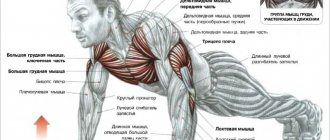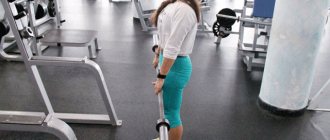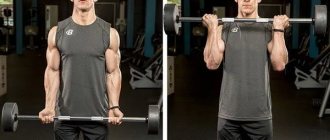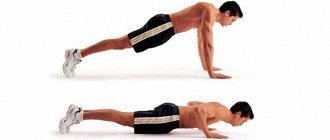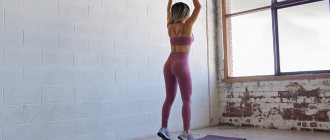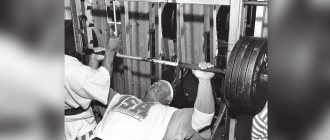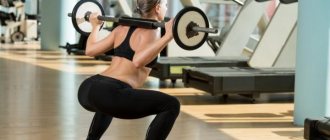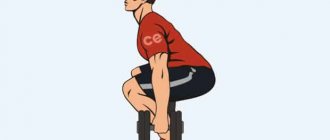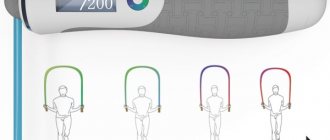In gym programs, bodyweight exercises are becoming increasingly rare. The complexes contain more exercises with free weights and on machines. But push-ups with all sorts of variations have not yet been forgotten. The advantages of this exercise are that variations of push-ups allow you to train muscles from scratch, or diversify the program with a new and effective technique.
Advantages and disadvantages
Benefits of push-ups
- Multi-joint exercise , which allows you to work several muscle groups without additional weights, with your own weight.
- The exercise can be performed anywhere - the gym or at home, and does not require much time and space.
- There are practically no contraindications to performing the exercise and it can be performed at any age. Only with spinal problems is it necessary to control the deflection of the lower back and keep your back straight so as not to aggravate the problem.
- You can do push-ups with any level of physical fitness , from beginner to experienced athlete, depending on the type of exercise chosen.
Flaws
- The exercise is not suitable for gaining muscle mass, since its complexity will not allow you to get the proper load with a small number of repetitions, with the exception of the option of push-ups with weights.
- At first, not everyone can do push-ups with their own weight on the floor; for this it is necessary to prepare the body and strengthen the muscles with preparatory exercises.
Basic types of push-ups. Execution technique
There are many varieties of push-ups, each of which is aimed at working a specific muscle group. Let's look at the most basic options.
Classic push-ups
The most common type of push-up
The classic version of push-ups is taught at school during physical education classes. The technique is quite simple:
- First, a lying position with support on your palms and toes is adopted.
- Legs and back are one straight line.
- The palms are located slightly wider than the shoulders. The fingers are not widely spaced and point forward.
- Feet together or hip-width apart.
- As you inhale, slowly bring your chest toward the floor, bending your elbows. Don't spread them too far apart.
- Exhale and return to the starting position.
Wide grip
This exercise works the pectoral muscles
The technique is similar to the previous one with some exceptions:
- Hands should be placed at a distance equal to approximately two shoulder widths.
- Elbows should be directed to the sides.
- You can gather your palms into a fist or do push-ups with open palms, as in the classic version.
- The legs are shoulder-width apart or slightly narrower.
- When lowering your body, you need to watch your elbows: they should always look to the sides.
- Your back, neck and head should form one straight line.
If you bend or stick out your buttocks, the effectiveness of the exercise will be significantly reduced. A wide grip allows you to maximally pump the pectoral and deltoid muscles.
Wide grip with maximum development of the pectoral muscles
Wide grip with maximum development of the pectoral muscles
This type of push-up is aimed at maximizing the development of the pectoralis major muscle. The technique is the same as in the case of a wide grip, only the legs must be placed on a hill. For beginners, a stand of 30–35 centimeters will be sufficient. Professionals can do push-ups with a stand of 60 centimeters. The higher the stand, the greater the load on the pectoral muscles. You can experiment with the width of your grip. The wider the grip, the greater the load.
Medium grip
This type of push-up is aimed at working the triceps.
The effectiveness of the exercise will depend on the correct placement of the hands.
- Hands should be placed strictly at shoulder level.
- The elbow joints should be directed back.
- Feet together.
- When lowering the body, the elbows move not to the sides, but back along the body.
- The body must be positioned strictly parallel to the floor.
- You can do push-ups on both your palms and your fists.
Narrow grip
Works the triceps and shoulder girdle well
A narrow grip promotes good development of the triceps and anterior deltoid muscles.
- The palms are located next to each other and directed slightly inward.
- Feet are shoulder-width apart or together.
- When lowering the body, the arms bend along the body, and do not diverge to the sides.
One-arm push-ups
This exercise works well on the pectoral and abdominal muscles.
Doing push-ups on one arm is quite difficult; you should switch to this version of the exercise only if classic push-ups do not provide enough load.
- To maintain balance, you need to spread your legs wide apart.
- The supporting arm is located at the shoulder line, and the other arm is slightly bent and placed behind the back.
- When the descent phase occurs, the elbow bends to the side.
- You can do push-ups, alternating your hand after each push-up, or do a few reps on one hand and then change your supporting hand.
Warm-up before push-ups
Any exercise requires a good warm-up to prevent injury. Warm up for 7-10 minutes on a treadmill or orbitrack, you can also do jumping rope. After warming up, perform several rotational movements with your wrists, elbows and shoulders. Stretch your chest muscles, triceps and begin the exercise.
Use of additional equipment
Training with additional objects can significantly increase the impact. This includes various weights, as well as supports that allow you to raise your legs or higher. This allows you to shift the center of gravity and translate it. A good way to stretch your muscles will be to exercise on chairs, which must be positioned in such a way that you can place your legs on one and your arms on the other two. When training, you should lower your body below the level of your elbows; accordingly, a strong effect on the muscles occurs and the result will be noticeable in the shortest possible time. The main thing is the correct arrangement of chairs. Otherwise, you may get injured. The use of weights is necessary to strengthen the back. It also helps develop strength. Additional weights allow for greater performance. Place weights in different parts of the back - the lumbar region, below the shoulder blades, the upper part of the back. The main thing is to give preference to exactly the load that you can work with.
There are so-called loads on the muscles, called polymetric.
Their main task is to perform the exercise in jerks, this allows you to gain not only dexterity, but also an excellent reaction. Please note that doing them does not contribute to weight gain. Their observance is similar to the usual ones, it is only important to push off as hard and sharply as possible - with a jerk.
Push-ups of this type are considered one of the most difficult exercises. Its main purpose is to target the muscles of the upper and shoulder torso.
To do this you don’t need any equipment, regularity is enough. After a few you will notice how the muscles begin to increase in volume, but to achieve this, you must do the following correctly:
• Hands must be shoulder-width apart and tilted; • It is necessary to rest your hands on the floor and lift yourself off the ground in such a way as to straighten your arms all the way. • It is very important that the body remains parallel to the floor throughout the entire session. • A mandatory point is the direction of your gaze and head, look at the wall or floor, this is necessary in order to avoid excessive blood flow. • Everything must be done with extreme care and slowly. Lower your body until your head touches the floor. • The more careful the execution, the greater the effect you will achieve, and the likelihood of injury will be much lower.
During exercises of this kind, almost all the muscles of the upper body are subject to the greatest load. The main thing is not to overdo it; it’s enough to do 2-3 sets of 10 repetitions.
In order to change the load, all I need is the position of my legs and arms. This type of training falls into the “moderate” category. The muscles of the chest and triceps are subject to the greatest load. The arms should be positioned in a special way to provide stability to the entire body. When exercising and lifting your body, do not forget to hold for a few seconds and then lower yourself very slowly. This way the impact increases. The buttocks and back should be in line for greater effectiveness.
Exercises performed with a narrow placement of the arms involve a straight position of the body, legs at the closest possible distance to each other, full straightening at the elbow joint when lifting the torso to the highest point. Thanks to the correct execution of this technique, all the necessary muscles are loaded, due to which the desired effect can be achieved in the shortest possible time. Please note that exercises of this kind are practically no different from the classical technique, the only difference is the support, which is the phalanges of the fingers.
You should train in such a way that the athlete needs to take a horizontal position, with his heels resting on a hard surface. Your arms should be bent at the elbows, reaching a perpendicular angle. The starting position should be taken so that all the impact occurs on the bones, or rather on the middle fingers.
After placing your hands correctly, you can proceed to the beginning of the exercise. Slowly the body must be lifted up from the floor, but not fully straightened at the elbow joints. It is important to keep your back and lumbar spine straight; your shoulders rise first. This exercise is considered difficult, which is why it should not be performed without prior preparation and too often; it is better to increase the number of approaches gradually. The benefits of this kind of training primarily go to athletes involved in impact sports, as they help strengthen not only the muscles, but also the bones in the upper body. If these loads cause discomfort for you, it is better to do everything in portions. Previously, there was an opinion that such training was exclusively for representatives of the stronger half of humanity. Now times have changed and trainers include this load in almost all fitness and aerobics programs.
Sets and repetitions of push-ups
If doing push-ups is difficult, do as many push-ups as possible until failure until the muscles stop working. If it has become very easy to do push-ups in all variations, add weights (pancakes, dumbbells) or master complex variations. Perform 3-4 approaches. You shouldn’t do push-ups every day; two workouts a week are enough to give your muscles time to recover.
Types of exercise
The result of classes depends on the selected elements and regularity. Some types of push-ups for beginners are aimed only at improving health and preventing diseases of bones or joints. Others exist to develop endurance, balance, strength and increase mass. In addition to the classic exercises, it is customary to highlight the following:
- with hands being torn off;
- clapping your hands in front of you and behind your back;
- with hands lifted at different distances;
- with a raised leg at a short distance;
- on your hands, with your legs raised on the wall;
- with an axis rotation of 90 degrees.
Push-ups are also good for your posture. To achieve a perfectly straight back, it is recommended to do push-ups from the wall or the floor, as well as from your knees on a support. Simple exercises do not require much strength, but have a beneficial effect on the muscular corset and skeletal system. Just 20 repetitions every morning will guarantee a straight back after several weeks of regular training.
T-shaped exercises are a complicated version of classic push-ups. Execution technique: starting position lying down, hands shoulder-width apart, legs closed together, knees straight. You need to do push-ups in the usual way, then return to the starting position and turn your body to the side, lifting one arm. The body should resemble the letter T. To achieve the desired result, you should not bend your back or arms. You can complicate the technique by picking up dumbbells. For a more challenging workout, there are advanced elements: push-ups on your fingertips, fists, one hand or on chairs.
With the help of push-ups, it is possible to increase testosterone levels, but girls should not be afraid of this. Its increase occurs exactly as much as the body requires. It is not allowed to start training immediately with difficult elements. Beginners need to learn how to perform classic push-ups correctly and only then move on to other types. If you can’t do push-ups correctly right away, you can do lighter exercises. For example, leaning against a wall, bench or step. It is also recommended to rest on your knees rather than your feet.
How to replace push-ups?
If you compare the working muscles during push-ups with other exercises, you can draw a parallel with some exercises with weights, for example, bench press, dumbbells or in a machine. In addition, after the muscles get used to push-ups, you can replace them with presses and progress further. But push-ups cannot be completely replaced, since when performing exercises while lying down, the stabilizer muscles do not work, which additionally work during push-ups, keeping the spine straight.
What muscles work during push-ups?
If you're wondering which muscles are activated during a push-up, here's the full list:
- Triceps brachii muscle, or triceps. They train while straightening their arms. If you do push-ups with a narrow grip, this muscle will develop much faster.
- Large pectoral muscles. This muscle group is responsible for rotation of the humerus, its abduction and adduction.
- Deltoid muscles. With their help, the contour and volume of the shoulders are formed. Although push-ups are not a special exercise for the delta, due to the fact that they work with absolutely all arm movements, push-ups provide significant development.
- Biceps muscles, or biceps. As such, no development is gained during push-ups, but overall strength and endurance increase.
- The serratus anterior muscles are located on the side of the chest on the upper ribs. During push-ups with a wide grip, they develop very well.
- The gluteus maximus muscles also develop. The buttocks become pumped up and firm.
- The abdominal muscles also receive a static load during push-ups.
